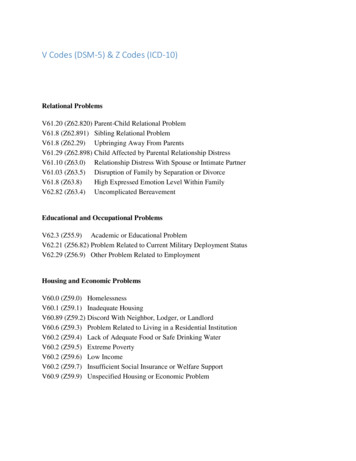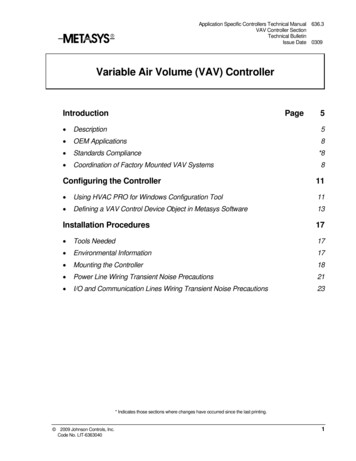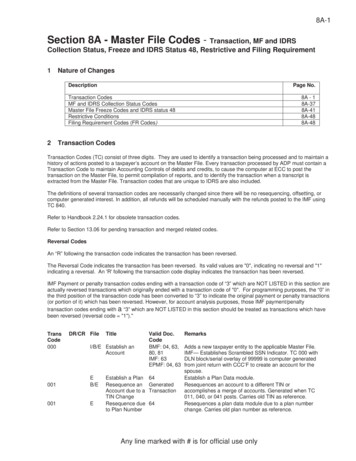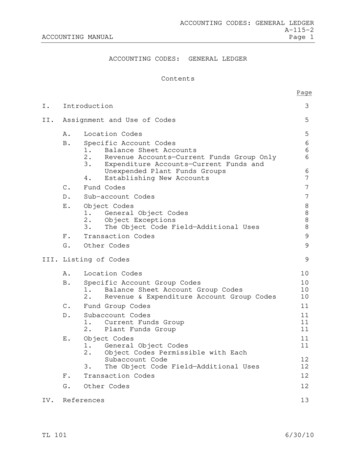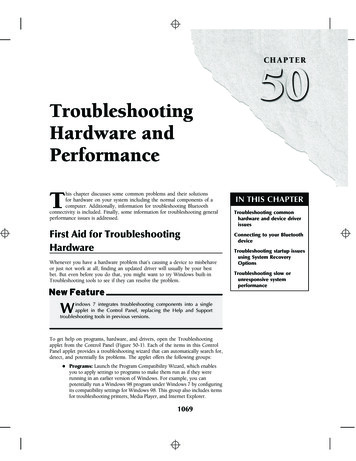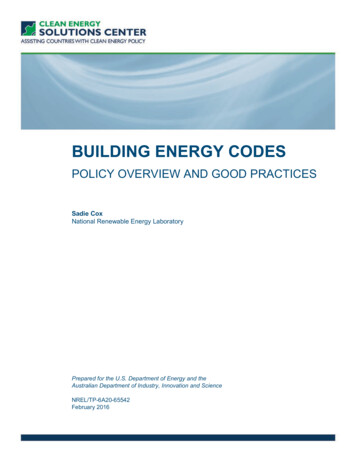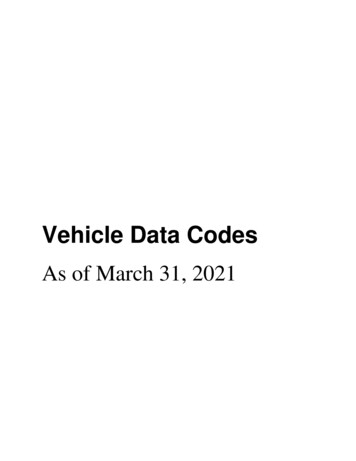
Transcription
Troubleshooting REScheckand COMcheck ProjectsBOB SCHULTZBuilding Energy Codes ProgramMay 9, 2019PNNL-SA-1433641
Course Description andLearning ObjectivesThis webinar, which is part of DOE's Building Energy Codes Program Energy CodesCommentator webinar-based training series, will present case studies reviewing challenges that can beaddressed via REScheck and COMcheck software, the popular compliance software tool supported bythe U.S. Department of Energy. Case studies will focus on common challenges which can result in noncompliance, and what design changes and user inputs can be implemented as a remedy. Both residentialand commercial projects will be covered, as will distinctions between various energy editions of modelcodes. Valuable troubleshooting techniques will also be presented using samples based on real-worldprojects.Learning Objectives:1.2.3.4.Attendees will learn what and how building envelope assemblies are calculated and thecompliance path from code is used to calculate a compliance result using REScheck.Attendees will learn what and how building envelope assemblies and lightingfixures/wattages are calculated and compliance paths from IECC and ASHRAE 90.1 usedto calculate compliance results using COMcheck.Attendees will learn what design changes have the biggest impact and how to change abuilding project that is failing to incompliance.Attendees will be able to apply troubleshooting techniques.Building Energy Codes Program2
REScheck Supported Energy CodesBuilding Energy Codes Program3
Residential Energy Code Compliance MethodsBuilding Energy Codes Program4
REScheck Supported Compliance MethodsTotal UAConsiders thermal conductance of envelope assemblies“Trades-off” UA from above-code assemblies to below-code assembliesUA U-factor x Area for each building assemblySum UA for Proposed Building compared to SUM UA for Code (Budget)BuildingPerformance alternativeConsiders the whole building energy performanceBased on simulated performance of your building compared to anequivalent code buildingRequires additional inputs (over UA approach): building orientation,minimum of four walls having unique orientations, and a minimum of oneroof and floorEnvelope trade-off only, no mechanical equipment trade-offBuilding Energy Codes Program5
Energy Code Envelope Assembly RequirementsBuilding Energy Codes Program6
Envelope Mandatory Requirements(Source: 2018 IECC)Building Energy Codes Program7
Diagnostic Data: Energy Code, ClimateZone, Project Type, Compliance MethodBuilding Energy Codes Program8
Diagnostic Data on Compliance CertificateBuilding Energy Codes Program9
Evaluate Assembly PerformanceBuilding Energy Codes Program10
Evaluate Assembly Performance (cont)Building Energy Codes Program11
Evaluate Assembly Performance (cont)Building Energy Codes Program12
Mandatory Requirement Fails ExampleBuilding Energy Codes Program13
COMcheck and Commercial Code ComplianceBuilding SystemCompliance isionsSWH(required for mostcompliance options)PowerLightingTrade OffOptionEnergy CodeComplianceEnergy CostBudget:PerformanceSimulationOtherBuilding Energy Codes Program14
COMcheck Commercial Energy CodesASHRAE 90.1 (Pre-2013)Normative Appendix CMethodology for Building EnvelopeTrade-Off Option90.1-2007/20102009/2012 IECCASHRAE 90.1-2013/2016 AppendixC has limited performance method(EnergyPlus)2015/2018 IECC ComponentPerformance Alternative (hybridTotal UA method)15
Envelope Trade-Off Methods (cont.)90.1-2007/2010 and 2009/2012 IECC : Normative Appendix C Methodology forBuilding Envelope Trade-Off Option Building energy cost factor computed using regression equations 90.1-2007/2010: Window/wall and skylight/roof ratio limitations enforced buttradable 2009/2012 IECC: Window/wall and skylight/roof ratio limitations enforced ashard limit90.1-2013/2016 Appendix C Envelope Trade-Off Methodology Envelope components are assigned to isolated thermal zones based on Building Envelope Area types (BEAT) play influential role Space conditioning categories (SCC) Window/wall and skylight/roof ratio limitations enforced but tradable2015/2018 Component Performance Method Criteria Envelope assemblies must pass on ‘hybrid’ Total UA based criteria Window/wall and skylight/roof ratio limitations enforced but tradable SHGC prescriptive requirement enforcedBuilding Energy Codes Program16
Project Types and Compliance MethodsNew Construction:Trade-off compliance methodPrescriptive – Oregon onlyAdditionTrade-off compliance methodPrescriptive – Oregon onlyAlterationPrescriptive complianceBuilding Energy Codes Program17
IECC Envelope Opaque Assembly Requirements(Source: 2018 IECC)18
IECC Envelope Fenestration Requirements(Source: 2018 IECC)19
90.1 Envelope RequirementsSource: 90.1-201020
90.1 Envelope Opaque Assembly Requirements21Source: 90.1-2010
90.1 Envelope Fenestration RequirementsSource: 90.1-2010Source: 90.1-201322
Project: Critical Diagnostic DataBuilding Energy Codes Program23
Project: Building Envelope Area TypesPrimarily impacts envelope complianceWhole building types that describe the envelope (separatingconditioned and unconditioned spaces)Space conditioning typeNonresidentialResidentialSemiheated (no mechanical cooling) – 90.1 onlyBuilding Energy Codes Program24
Diagnostic Data on Envelope ReportBuilding Energy Codes Program25
Example: TBD due to incomplete specificationAfter you’ve entered building components, look at compliance resultLook for fields with red textIf TBD, look for missing dataBuilding Energy Codes Program26
Fenestration Performance and ComplianceNFRC site-built certified productPerformance evaluated (per NFRC guidelines)Energy code defaultsBuilding Energy Codes Program27
Example: 2015/2018 IECC Fenestration SHGCNoncompliance Using Energy Code Default Option‘Energy code default(s)’ do not mean fenestration performance requirement will be appliedBuilding Energy Codes Program28
Envelope: 2015/2018 IECC FenestrationRequirementsMenu View- Glazing RequirementsBuilding Energy Codes Program29
Example : 2015 IECC Project failing due towindow/wall percentage enforcementBuilding Energy Codes Program30
Example : 2015 IECC Project failing due towindow/wall percentage enforcement (cont)Building Energy Codes Program31
Example : 2012 IECC Project failing due towindow/wall percentage enforcement (cont)Building Energy Codes Program32
Example : 2015 IECC Project failing due towindow/wall percentage enforcement (cont)Passes when daylighting allowance is selected:Building Energy Codes Program33
Example : 90.1-2013 project fails due to internal gains from solar heatBuilding Energy Codes Program34
Example : Metal Building Roof LinerspecificationBuilding Energy Codes Program35
Example : Metal Building Roof Linerspecification (cont)Climate zone 3 requires “R-19 R-11 LS”(Liner System) or U-0.035Building Energy Codes Program36
Example : Metal Building Roof Linerspecification (cont)Building Energy Codes Program37
Example: Slab-On-Grade misspecficationBuilding Energy Codes Program38
Example: Slab-On-Grade Construction DetailsBuilding Energy Codes Program39
Example: 90.1-2013/2016 Glazing OrientationModelling requirement: If the majority of window area faces east and west, COMcheck must model and simulatethe code (budget) building 4 times, with the front facing each of the 4 cardinal orientations in turn, then average the4 energy performance results and compare that result to the proposed energy cost factor.Building Energy Codes Program40
Example: 90.1-2013/2016 Glazing Orientation (cont)Rotate the orientations of each wall 90 degrees and the project passes.Building Energy Codes Program41
Example: 90.1-2013/2016 Glazing Orientation (cont)Building Energy Codes Program42
U.S. DOE: Building Energy Codes ProgramResourcesCompliance softwareTechnical supportCode notesPublicationsResource guidesTraining materialswww.energycodes.gov43
THANK YOU!Building Energy Codes Programwww.energycodes.govBECP help deskhttps://www.energycodes.gov/HelpDeskBuilding Energy Codes Program44
software, the popular compliance software tool supported by the U.S. Department of Energy. Case studies will focus on common challenges which can result in non-compliance, and what design changes and use
